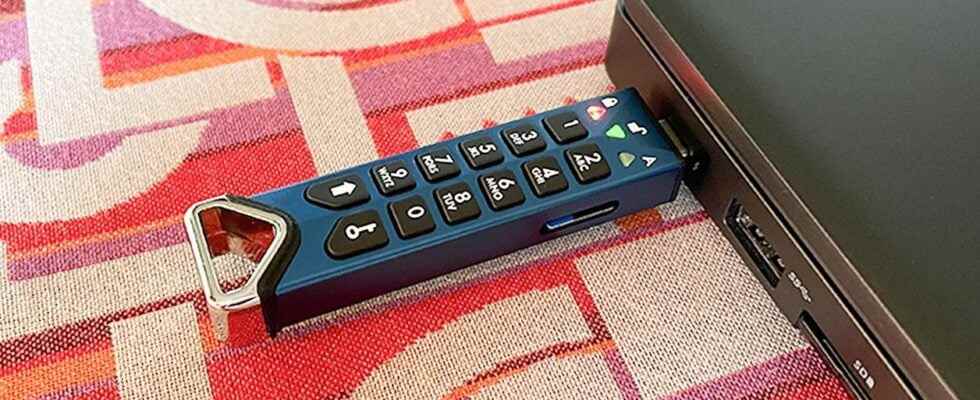How to transport your sensitive data without going through the cloud? By using a secure USB drive with hardware-enabled data encryption. The manufacturer iStorage specializes in this area and offers several products, for example the datAshur Pro². Unlocking is done using the integrated numeric keypad, by entering a code defined in advance. This system eliminates the need for software and is thus compatible with any operating system that accepts USB keys.
The new datAshur SD model goes one step further by using a microSD memory card for data storage, instead of internal memory.
It is therefore possible to easily increase the storage capacity, without having to buy a new USB key. And for added security, you can store the card separately, somewhere other than the key. However, with one big downside: the datAshur SD only accepts iStorage microSD cards. This constraint was confirmed during our tests, with the key rejecting microSD cards from other manufacturers.
It’s all the more unfortunate that the manufacturer’s microSD cards are more expensive than excellent models, such as the Extreme Pro, from SanDisk. However, buying a card is still more advantageous than buying a new USB key, as shown in the table below.
For equal capacity, the datAshur SD is also cheaper than the datAshur Pro², which does not have a 1 TB version.

Note that the datAshur SD comes with a sturdy metal protective case, as well as a USB Type-C to USB Type-A adapter.

On first use, we had to set the unlock code and format the key (exFAT for greater compatibility). For the code, a reading of the user manual is necessary to know how to use the two additional keys on the keyboard (Shift and Key).
Important point: the microSD card is then totally unreadable, if you try to use it outside the datAshur SD, for example with a USB microSD reader.
Decent write speeds, but far from the best
We then moved on to speed tests using two memory cards from iStorage: one 64 GB and one 512 GB. Both cards are V30 and U3 certified (write speed of 30 MB/s or more). The manufacturer does not give any indication of the speeds, but indicates that the 512 GB card is better suited to the simultaneous execution of several programs (A2 certification) than the 64 GB card (A1 certification).

With the CrystalDiskMark speed test, we see very close sequential read speeds between the two cards. The difference lies in the sequential writes, which range from single to double.
But anyway, the datAshur SD does not exceed 95 MB/s. The score is honorable for USB 3.2 Gen1, but well below what high-end USB keys can offer.
So in our tests, the SanDisk Extreme Pro achieved 371 MB/s read and 284 MB/s write. SanDisk also offers a microSD memory card in its Extreme Pro range, which according to our measurements reaches 166 MB/s in reading and 105 MB/s in writing. But it is unfortunately incompatible with the datAshur SD. The incompatibility of third-party solutions with this key is all the more regrettable.
Finally, iStorage offers KeyWriter software to clone the encryption characteristics of a datAshur SD key onto other copies.

The operation is simple and allows, for example, to keep a backup USB key that will be able to decrypt the data encrypted with the master key, even if the latter is lost. But in this case, you must have had the reflex to remove the microSD card beforehand. In the end, the datAshur SD has the advantages of its ease of use, its possibility of changing the storage capacity or using several microSD cards, as well as its independence from the operating system. However, it is a pity that it is not faster, and, above all, that iStorage does not allow the use of microSD cards from other manufacturers.
